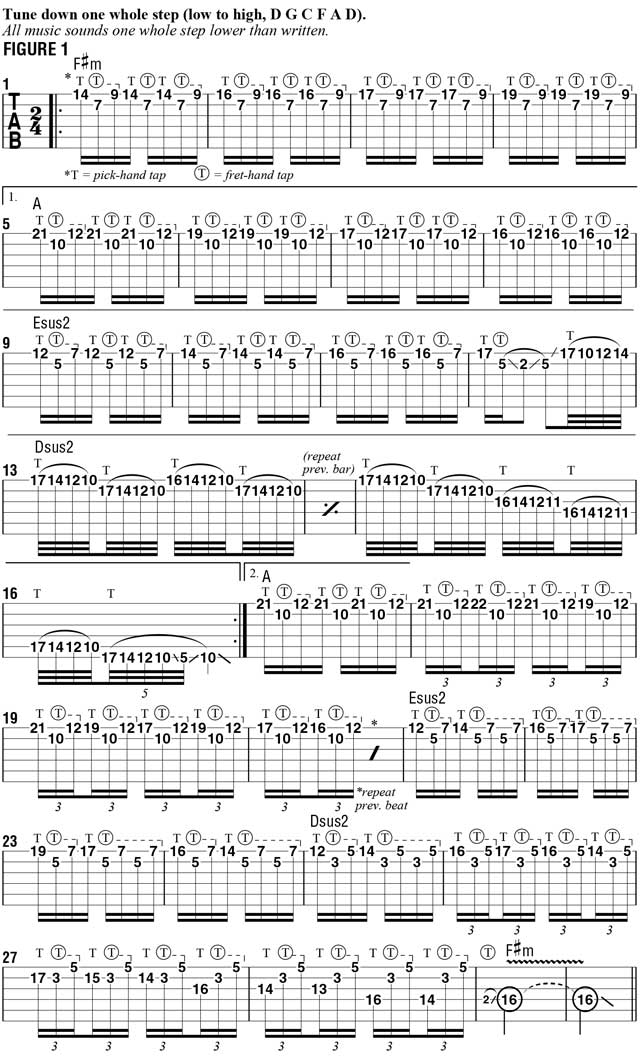Theme and Development: Two-Hand Percussive Tapping Variations

As I demonstrated in my debut Guitar World column last month, a favorite technique of mine is percussive tapping, wherein notes and specific rhythmic patterns are sounded by tapping onto the fretboard with the fingers of both hands.
To me, this technique is akin to a drummer performing specific syncopations with two sticks, except I’m using my fingertips to simultaneously create rhythmic and melodic patterns while also outlining chords.
I love the way drummers will move freely between rhythmic patterns like triplets and “quads” (four-note patterns) in the formulation of shifting syncopations. The difference between hitting a drum and fretboard tapping on the guitar is that the guitar allows one to sound an endless variety of melodies and chord patterns while “drumming.”
Last month, I applied percussive tapping to a 12-bar blues progression. This month, I’d like to present a more complex 16-bar example played over a standard rock-type chord progression. As I had done last month, two fret-hand fingers, this time the index and ring, tap out an ostinato (repeating) figure on the top two strings that serves to lay down the reference to the chord progression, while the pick-hand index finger taps out syncopated melodic lines, primarily on the high E string.
Throughout FIGURE 1, a “T” represents a note sounded with an index-finger tap, and a circled “T” represents a note tapped with the fret-hand index or ring finger. Starting with a rhythm of 16th notes, the lick begins with a pick-hand tap, followed by two consecutive fret-hand taps, then another pick-hand tap. Across the first two bars, I tap an F#5 chord with my fret hand while my pick hand taps an ascending Fs natural minor scale (F# G# A B C# D E).
At bar 3, the fret-hand taps move up three frets to sound A5, and this reference to A major, the relative major chord and key of F# minor, changes the reference of the notes to the A major scale (A B C# D E F# G#). In bars 5 and 6, the fret-hand taps shift to E5 while the pick-hand melody moves to notes based on the E major scale (E F# G# A B C# D#). At the end of bar 6, a new figure commences, in straight 32nd notes, and serves to initiate the fast, repeating tapped/descending figures in bar 7 that are stationed on the top two strings.
Though played over a Dsus2 chord, this melodic line is based on the A major scale, with the pick-hand tap falling on each eighth-note “downbeat.” In bar 8, the figure then moves across all the strings in 10th position. The second eight-bar section begins at bar 9, with a restatement of bars 1 and 2 in bars 9 and 10.
Beginning on beat three of bar 11, I shift to fast 16th-note triplets in a thematic development of the melodic ideas. Be sure to play through all of the different individual elements of each phrase slowly before attempting to play the entire example from beginning to end at a fast tempo.

Get The Pick Newsletter
All the latest guitar news, interviews, lessons, reviews, deals and more, direct to your inbox!









![Joe Bonamassa [left] wears a deep blue suit and polka-dotted shirt and plays his green refin Strat; the late Irish blues legend Rory Gallagher [right] screams and inflicts some punishment on his heavily worn number one Stratocaster.](https://cdn.mos.cms.futurecdn.net/cw28h7UBcTVfTLs7p7eiLe.jpg)
